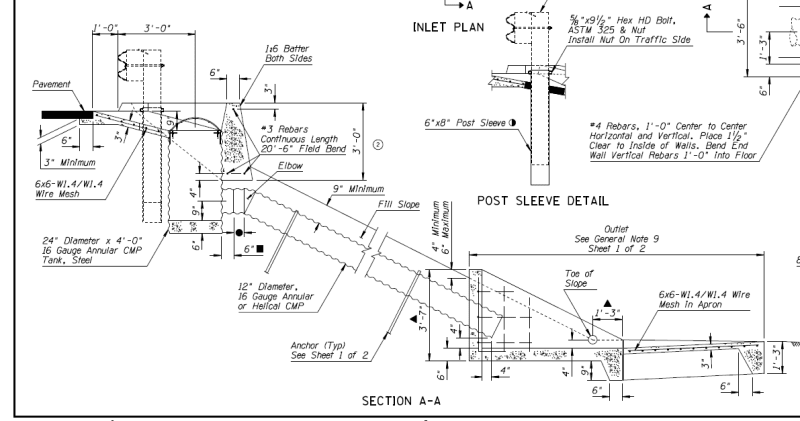A culvert on a 17% slope will have very high flow velocities and supercritical flow. High velocities means pipe wall erosion is a possibility, especially if your flow has a lot of rocks, soil, and debris. Supercritical flow means that a radical decrease in the pipe slope downstream of the 17% reach will produce a hydraulic jump.
-
Since I don't what your design flow or design material are, I decided to check this as an RCP culvert (Mannings n=0.013). Here are my results at selected depth ratios:
[tt]D/d --- Q --- V ----- NF
10% 12.4 cfs 18.9 fps 6.4
30% 116.0 cfs 36.6 fps 6.9
50% 296.1 cfs 47.1 fps 6.6
70% 495.9 cfs 52.8 fps 5.8
90% 631.2 cfs 53.0 fps 4.2[/tt]
The American Concrete Pipe Association (concretepipe.org) says, on their FAQ page, "At velocities up to 40 feet per second, the severity of velocity-abrasion effects depends upon the characteristics of the bed load." (
The ACPA Concrete Pipe Design Manual (
says "Maximum Velocity. Tests have indicated that concrete pipe can carry clear water of extremely high velocities without eroding. Actual performance records of storm sewers on grades up to 45 percent and carrying high percentages of solids indicate that erosion is seldom a problem with concrete pipe." You should be able to find similar information for corrugated metal pipes, HDPE, etc., either through additional internet sleuthing or by contacting pipe manufacturers.
I don't like to see velocities that high (in the flat country of the San Joaquin Valley, it's not an issue) and I like to avoid supercritical flow when possible. For your slope, would a combination of flatter slopes and drop structures work? Regardless, it appears that laying concrete pipe on a 17% slope is not out of line according to the ACPA. I just don't like it.
============
"Is it the only lesson of history that mankind is unteachable?"
--Winston S. Churchill



![[smile] [smile] [smile]](/data/assets/smilies/smile.gif) ). Since this culvert will be under a road and you are close to a 20% slope, you may want to be conservative and install a couple/a few anchors regardless of the requirements.
). Since this culvert will be under a road and you are close to a 20% slope, you may want to be conservative and install a couple/a few anchors regardless of the requirements.